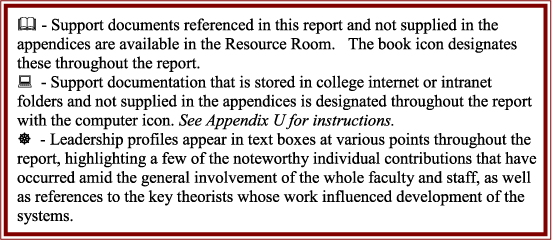

Summary of Responses to Identified HLC
Concerns
1. A clear philosophy
statement regarding general education as developed and agreed upon
by the faculty of the college.
The general education philosophy statement was written after a full
faculty discussion session after the first general education data
collection cycle. The competencies were streamlined, standards for
measurement were agreed upon, and purpose was clarified. The
written draft of the statement was presented back to faculty for
comments and suggestions. Those were distilled, and the final
written draft was adopted by unanimous vote at the Curriculum and
Policy Committee.
2. Specific outcome
competency expectations for each of the areas of general education
identified as necessary by the faculty of the
college.
The six competencies, Communications, Research, Technology, Ethics,
Problem Solving, and Mathematics and Quantitative Reasoning were
originally broken down into broad statements of student outcomes.
Completion of the first data collection cycle afforded an
opportunity to provide specific competency outcomes as a model for
continuing assessment. After the first general education
aggregation, individual instructors were grouped by the competency
which they reported. They were asked to look for commonalities
among their expectations and the things they actually valued and
measured. From this list of common concerns, each competency's
expanded objectives were tied to a measurable student outcome. This
became the basis for the checklists which are currently in use by
all faculty in their assessment of general education during the
3-year cycle.
3. Quantifiable measures
of student attainment of competency for each area of emphasis in
general education and strategies, timelines, and individuals
responsible for gathering each set of
information.
The general education competency checklists allow for individual
instructors to design whichever assessment event best fits their
instructional style. Instructors are asked to gauge students demonstrated ability in several areas of each competency. Because
the checklists use the same criteria from instructor to instructor,
the results are easily quantifiable and can be electronically
aggregated in order to provide a broad portrait of success for each
measure. The assessment plan outlines the cycle of collection and
reporting, shows how the data is collected by the general education
sub-committee, how it is aggregated and presented to faculty for
discussion, and the timeline for incorporating instructional and
operational changes related to the discussion.
4. Specific program
outcome competency expectations for each separate career
program.
The Assessment Folder houses the established list of objectives for
each course and program of both career and transfer programs.
5. Evidence of data
collected from direct measures of student academic achievement
along with any data collected from indirect
measures.
The Assessment Folder houses the results of each data collection
cycle from each instructor, discipline, area or program. The report
forms have a description/discussion section which allows
instructors to input qualitative, anecdotal, or indirect
measures.
6. Evidence that the
assessment process is communicated to students.
Each course syllabus for the College has an assessment statement
which gives students an overview of the process and explains their
role in the data collection. The student assessment brochure, given
to students in orientation and by many instructors on the first day
of classes, further details for students the process of becoming
active participants in their own learning.
7. A plan to cycle
assessment data and information back and to link that information
to a plan for improving instructional effectiveness in each
area.
The assessment plan outlines the yearly collection, reporting, and
discussion cycle in which all faculty participate. The plan
provides a narrative and a visual flow of data from all three
threads of academic assessment. Data from individual courses is
discussed at the discipline level, and plans of action are created
and acted upon for the following cycle. Discipline-level data is
brought together at the area or program level, and discussion and
plans of action are created for these larger units for the
following cycle. The general education competency data is collected
by individual instructors and aggregated institutionally. This data
is returned to faculty by the general education subcommittee at an
annual forum where results are discussed, and individual areas can
then fill out action plans based on the perceived need for
instructional change.
8. A clear plan for
connecting the needs as identified through the assessment process
to the annual budgeting effort at the college.
The action taken by the strategic planning task force resulted in
an integrated model by which assessment results which culminate in
budgetary requirements are directed through two places in the
system for prioritizing. First, assessment summaries of results are
sent to OPIC, the committee charged with prioritizing instructional
needs. The yearly report is available in the resource room. Secondly, areas are meeting yearly with their facilitators and
deans to complete the operational plans. Plans are aligned to the
strategic goals of the College, and budgetary requests are filed
from requests by faculty for perceived needs to fulfill their
operational plans.
9. A section of the budget
specifically devoted to the various aspects and needs in developing
and sustaining an effective assessment program.
The budget line has allocated assessment funds into both faculty
development and system development. Documents for both are in
Appendix S.








